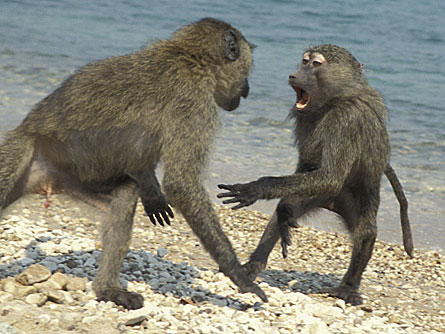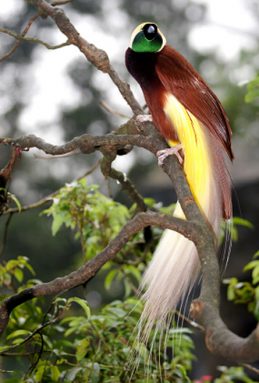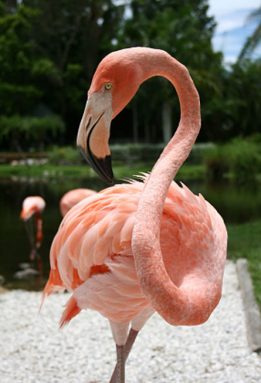Puberty gone wild
Humans aren’t the only animals that endure the awkward transition to maturity
By Susan Gaidos
 |
|
For most mammals, puberty is marked by an increase in aggression. As animals reach reproductive age, they often have to establish themselves in their herd or social group. In species where males compete for access to females, signs of aggressive behavior can begin at a young age.
|
| John Waters / Nature Picture Library |
Breakouts, mood swings and sudden growth spurts: Puberty can be downright awkward. Even if you’re not of the human species.
Puberty is a period in which humans move from childhood to adulthood. During this transition, the body goes through many physical and emotional changes.
But humans aren’t the only creatures to experience dramatic changes as they mature. Jim Harding, a wildlife information specialist at Michigan State University, says all animals — from aardvarks to zebra finches — go through a period of transition as they take on adult characteristics and reach sexual maturity, or the ability to reproduce.
“If you look at it that way, you could say that animals go through a kind of puberty, too,” he says.
For animals, the awkwardness of growing up is also not just a physical phenomenon. It’s social and chemical, as well. While they may not have zits to contend with, many animals change their coloring or body shape as they mature. Others take on a whole new set of behaviors. In some cases, animals are forced to leave their social group once they reach sexual maturity.
Just as in humans, the process of moving from a juvenile animal to a full-fledged adult is driven by changes in the body’s hormones, says Cheryl Sisk, a neuroscientist at Michigan State University. Hormones are important messenger molecules. They signal to cells when to turn on or off their genetic material, and play a role in every aspect of growth and development.
When the time is right, certain hormones tell the body to start the changes that come with puberty. In humans, this process begins when the body sends a chemical signal from the pituitary gland in the brain to the sex organs.
This brings about many changes in the body. Girls start to gain curves and menstruation begins. Boys develop facial hair and may hear their voice crack from time to time. Boys and girls also go through all sorts of emotional changes at puberty.
Animals go through a similar process. In nonhuman primates, it’s not all that different from humans. Monkeys, chimpanzees and gorillas — all genetically similar to humans — go through many of the same biological changes as humans do. Females begin having monthly menstrual cycles, and males become larger and more muscular.
Some primates go through a change that humans, fortunately, don’t go through: Their rump color changes to red. This happens when the animals gain sexual maturity, Sisk says. “That’s a sign of being fertile or receptive.”
The age at which the maturation process begins in an animal depends on the species. In rhesus monkeys, for example, pubertal changes start around 3 to 5 years of age. Just as in humans, the maturation process can take years, Sisk says.
Fighting for status
For most mammals, puberty is marked by an increase in aggression, says Ron Surratt, director of animal collections at the Fort Worth Zoo in Texas. The reason? As animals reach reproductive age, they often have to establish themselves in their herd or social group. In species where the males have to compete for access to females, signs of aggressive behavior can begin at a young age.
Monkeys, for example, often give up the rough-and-tumble play they engaged in as juveniles and begin showing more interest in the opposite sex. And male gorillas between the ages of 12 and 18 become much more aggressive as they begin to compete for access to mates.
This punky, teenage period in male gorillas is a time to try to test boundaries, says Kristen Lukas, a psychologist who specializes in animal behavior. She should know: Her job at the Cleveland Metroparks Zoo is to keep these unruly apes in line.
During puberty, these cocky young male gorillas may try to pick fights with older males, or threaten other guys in the group. Often, they act as if they have more power or control than they actually have, Lukas says.
In the wild, such behavior is rewarded with the right to breed. But in zoos, managers must try to manage or prevent such aggression in young males.
“It can be a very difficult time to manage the males through,” she says. “But once they get past puberty and they’re more mature, they settle down and they make good parents.”
Gorillas aren’t the only animals that get a bit testy during puberty.
Male antelopes, for example, will use their horns to spar with one another beginning at the age of 12 to 15 months. When puberty hits, such play-fighting may give way to all-out aggression. As the males get older and larger, they may take on the older males, knowing that the strongest animal gets the herd.
Similar struggles for dominance occur among elephants, Surratt says. “As the young, immature bulls start to mature, you’ll see them pushing each other around. This becomes much more intense as they start to reach adulthood. They’re basically fighting for the right to breed.”
Taking shape
For some animals, size is just as important as age when it comes to reaching sexual maturity. Turtles, for example, have to reach a certain size before they can take on adult characteristics. Once they reach the right proportions, their bodies begin to transform.
Male wood turtles, for example, look just like the females until they reach about 5 1/2 inches in length. At that time, the males’ tails become longer and thicker. Their bottom shell changes shape, too, taking on an indentation that makes it look somewhat concave. The change in males’ shell-shape allows them to mount females during mating without falling off.
Male slider turtles and painted turtles go through a different, more bizarre kind of change as they mature: In these species, the males develop long fingernails. The nails grow gradually, over a period of about a month. They are then used to tap out vibrations on the face of the females during courtship.
Some animals go through two major transition periods as they mature. Frogs and salamanders, for example, go through metamorphosis — moving from a larval stage to a tadpole — before they take on their adult form. They then have to grow to a certain size before they can reproduce. That may take several months to a year, says Harding, who specializes in herpetology — the study of amphibians and reptiles.
 |
|
Some animals go through two major transition periods as they mature. Frogs, for example, go through metamorphosis — moving from a larval stage to a tadpole — before they take on their adult form.
|
| Simon Colmer / Nature Picture Library |
The average frog, for example, will remain a tadpole over the summer months and may not breed until the following year. Before it’s able to reproduce, the frog goes through a growth spurt, getting larger in size. Its spot pattern or color pattern may also change.
Salamanders follow a similar growth pattern. A young salamander will metamorphose, but not get its full adult coloration for some time, says Harding.
“I get a lot of calls from people who say, ‘I found this weird salamander. It’s kind of small and I’ve looked at the field guides and can’t find anything that matches it,’ ” Harding says. He explains, “That’s probably because it has a juvenile coloration, which will gradually change into the adult color pattern.”
Looking good
 |
|
Many types of birds develop elaborate plumage when they hit puberty. In some species, such as birds of paradise, males gain colorful, eye-popping feathers while females remain rather drab-looking by comparison.
|
| oariff/iStockphoto |
For all critters, the changes that occur during puberty have evolved for a single reason: to help them reproduce. In order to succeed at this task, they first have to attract a mate. No problem.
While animals can’t go to the mall to purchase image-boosting accessories to attract the opposite sex, they’ve developed some clever strategies of their own. Many types of birds, for example, develop elaborate plumage when they hit puberty.
In some species, such as birds of paradise, the males gain colorful, eye-popping feathers while the females remain rather drab-looking by comparison. In other species, both males and females take on a flashier hue. In flamingos, for example, both sexes turn a bright shade of pink when they hit puberty.
 |
|
In flamingos, both sexes turn a bright shade of pink when they hit puberty.
|
| jlsabo/iStockphoto |
Along with these new adornments come behavioral changes. Even before they’re in full adult plumage, most birds start learning new postures, calls or moves that are used to communicate with other members of their species.
With all this growth and learning taking place so quickly, pubescent animals, like humans, can appear a little klutzy at times. But just like their human counterparts, animals eventually fill out, shape up and make their way through it.







